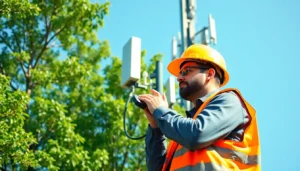
In a world where staying connected is as essential as breathing, telecommunications networks are the unsung heroes of modern life. They’re the invisible threads weaving together our conversations, streaming marathons, and that sweet, sweet cat video you just can’t resist. But have you ever stopped to wonder what makes all this magic happen?
Telecommunications Networks
Telecommunications networks form the backbone of modern communication. They encompass a variety of technologies that connect users through wired and wireless mediums. Different types of networks exist, including public switched telephone networks, cellular networks, and satellite systems. These networks facilitate everything from voice calls to high-definition video streaming.
Components of telecommunications networks include transmitters, receivers, and routers. Transmitters encode and send signals, while receivers decode incoming information. Routers direct data packets across networks, ensuring that messages reach their correct destinations quickly and efficiently.
Protocols such as TCP/IP and UDP govern data transmission, providing rules that devices must follow for successful communication. Such standardization allows diverse devices to interoperate seamlessly. Network capacity and bandwidth influence performance significantly, determining how much data can be transmitted and the speed of communication.
Local Area Networks (LAN) and Wide Area Networks (WAN) are among the most common types. LANs serve limited areas like homes or offices, while WANs span broader geographic regions, connecting multiple LANs across cities or countries. Businesses rely heavily on these networks for operations, enabling efficient communication and collaboration.
Emerging technologies like 5G promise to enhance telecommunications networks further. By increasing speed and reducing latency, these advancements enable new possibilities for Internet of Things devices and smart cities. Organizations brace for continued evolution in telecommunications, anticipating further integration of artificial intelligence and machine learning to optimize network performance.
Types of Telecommunications Networks

Telecommunications networks can be categorized into various types, each serving specific purposes and user requirements. The primary types include fixed networks and mobile networks, which together encompass the vast landscape of communication technologies.
Fixed Networks
Fixed networks rely on physical infrastructure, including copper wires and fiber optics, to connect users. They provide stable connections suitable for residential and commercial use. Public switched telephone networks represent traditional fixed networks, enabling voice communication through landlines. Fiber optic networks deliver high-speed internet access, supporting activities like video streaming and online gaming. These networks often include tasks such as data transmission and routing, relying on hardware like switches and routers for efficient performance. Various service providers offer fixed network solutions, making them prevalent for both individual and organizational needs.
Mobile Networks
Mobile networks make communication accessible on the go, enabling connectivity through cellular technology. Users can engage through voice calls, text messages, and mobile data without a physical connection. Technologies such as 4G and 5G define mobile networks, delivering increased speed and lower latency. The architecture of mobile networks incorporates base stations, towers, and mobile switching centers that manage user connections seamlessly. Users experience enhanced services like video conferencing and internet browsing, reflecting the growing demand for mobility. Service providers continuously expand coverage, ensuring network availability for urban and rural users alike.
Key Technologies in Telecommunications Networks
Telecommunications networks utilize various technologies to facilitate effective communication. These technologies enable seamless connectivity across different platforms and devices.
Transmission Media
Transmission media consists of the physical pathways that carry signals. Copper cables serve as traditional wiring for telephone communications, providing a reliable means for data transmission. Fiber-optic cables utilize light to transmit data over long distances with minimal loss, ensuring high bandwidth for tasks like video streaming. Wireless transmission relies on radio waves to connect devices without physical connections. Satellite links extend connectivity to remote areas, supporting global communications. Each medium presents unique advantages, catering to specific user needs and environmental conditions.
Network Protocols
Network protocols are essential for governing data exchange. Transmission Control Protocol/Internet Protocol (TCP/IP) specifies how data packets are formed, transmitted, and received across networks. User Datagram Protocol (UDP) ensures low-latency data transmission ideal for applications like online gaming and voice calls. Hypertext Transfer Protocol (HTTP) regulates data transfer for web communications, making online browsing possible. Simple Mail Transfer Protocol (SMTP) facilitates the sending of emails, ensuring effective messaging. These protocols enable interoperability among diverse devices and platforms, maintaining efficient communication in telecommunications networks.
Challenges in Telecommunications Networks
Telecommunications networks face several challenges that impact their functionality and effectiveness. These challenges stem from evolving technologies and the increasing demand for reliable connectivity.
Security Issues
Security issues represent a significant challenge in telecommunications networks. Cyber threats, such as hacking and data breaches, place sensitive user information at risk. Encryption protocols and secure access mechanisms serve as vital defenses, yet evolving tactics from cybercriminals pose continuous threats. Organizations must adapt their security strategies to maintain user trust and protect data. Regular updates and monitoring strengthen network resilience against potential vulnerabilities. As users become more aware of security risks, transparency in security measures grows increasingly important.
Infrastructure Limitations
Infrastructure limitations also hinder telecommunications networks. Aging equipment and outdated technology contribute to slower service and reduced reliability. Many areas still rely on outdated copper wiring, which struggles to support modern data demands. Investing in fiber-optic technology offers faster speeds but requires significant capital and time. Deployment can take years, especially in rural regions where access remains limited. Additionally, regulatory hurdles can delay infrastructure upgrades and expansion plans. Ensuring adequate infrastructure not only improves service quality but also positions networks to accommodate future growth.
Future Trends in Telecommunications Networks
Telecommunications networks are evolving quickly. Several key trends are shaping the future of this critical infrastructure.
5G Technology
5G technology stands at the forefront of telecommunications advancements. Enhanced speed and reduced latency characterize this next generation of mobile networks. Users experience significantly improved responsiveness, enabling applications that require real-time data processing. Businesses benefit from the increased capacity, allowing more connected devices without compromising performance. With its rollout, deployment across urban and rural areas impacts connectivity, fostering new innovations in various sectors like healthcare and transportation. Continued investment in infrastructure supports the widespread adoption of these technologies.
Internet of Things (IoT) Integration
IoT integration transforms telecommunications networks by connecting everyday devices. As smart home products and industrial sensors proliferate, seamless communication becomes essential. Enhanced network capabilities support massive device connectivity, paving the way for smarter cities and efficient resource management. Real-time data analysis gathers insights into user behavior, improving service delivery. Moreover, IoT applications in telehealth and smart agriculture enhance operational efficiencies and monitor critical processes. Telecommunications providers recognize the importance of these integrations, preparing to support an ever-expanding ecosystem.
Conclusion
Telecommunications networks are indispensable in today’s interconnected world. They not only facilitate communication but also drive innovation across various sectors. As technology continues to evolve with advancements like 5G and the Internet of Things, these networks are set to become even more integral to daily life.
The challenges of security and infrastructure must be addressed to ensure reliable service. By investing in modern technologies and robust security measures, organizations can enhance user experience and maintain trust. The future of telecommunications promises exciting developments that will reshape how people connect and interact, making it essential to stay informed and prepared for these changes.








